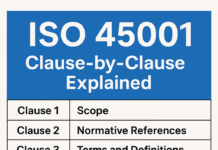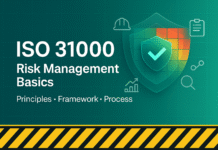
What is ISO 45001:2018?
If you’re new to the world of occupational health and safety (OHS), you’ve probably heard of ISO 45001:2018 and wondered what it’s all about. In simple terms, it’s an international standard that provides a framework to improve employee safety, reduce workplace risks, and create better working conditions.
But that’s just the tip of the iceberg. Let’s dive deeper.
Introduction to Occupational Health and Safety (OHS)
Why Workplace Safety Matters
Think about it—no one wants to work in an unsafe environment, right? Injuries, illnesses, and even fatalities can happen when safety is not a priority. Beyond the human cost, unsafe workplaces lead to lost productivity, legal battles, and damaged reputations.
Common Workplace Hazards
From slippery floors in a restaurant to chemical exposure in a factory, hazards vary across industries. Some common ones include:
- Falls and trips
- Electrocution
- Exposure to toxic substances
- Repetitive strain injuries
- Fire hazards
The History and Background of ISO 45001
Evolution from OHSAS 18001 to ISO 45001
Before ISO 45001, companies followed OHSAS 18001, a British standard for OHS. However, ISO 45001 was developed to unify global safety practices and offer a more integrated management approach.
Who Developed ISO 45001?
It was published by the International Organization for Standardization (ISO) in March 2018. Experts from over 70 countries contributed to this global standard.
Understanding ISO 45001:2018
Definition and Purpose
ISO 45001:2018 is an International Standard for Occupational Health and Safety Management Systems (OHSMS). Its goal is to prevent work-related injuries and illnesses and to proactively improve workplace safety.
Key Features of ISO 45001
- Risk-based thinking
- Leadership involvement
- Worker participation
- Integration with other ISO standards like ISO 9001 and ISO 14001
The Core Structure of ISO 45001
The PDCA (Plan-Do-Check-Act) Model
This model helps organizations continually improve. Here’s a quick breakdown:
- Plan: Identify risks and opportunities
- Do: Implement safety measures
- Check: Monitor and measure performance
- Act: Take actions to improve
Annex SL: The Framework for ISO Management Systems
ISO 45001 follows Annex SL, a high-level structure that ensures consistency across ISO standards.
Main Clauses of ISO 45001:2018
Context of the Organization
Understand internal and external issues affecting your OHSMS.
Leadership and Worker Participation
Top management must take an active role. Worker involvement is equally crucial.
Planning and Risk Management
Identify hazards, assess risks, and plan control measures.
Support and Operational Control
Ensure resources, training, and communication are in place.
Performance Evaluation and Improvement
Monitor incidents, conduct audits, and make improvements.
Benefits of ISO 45001 Implementation
Reduced Workplace Injuries
Fewer accidents mean less downtime and happier employees.
Legal and Regulatory Compliance
Helps meet national and international OHS laws.
Enhanced Company Reputation
Customers and clients trust companies that value safety.
Who Should Implement ISO 45001?
Applicability to All Business Sizes and Sectors
Whether you’re running a construction site or a corporate office, ISO 45001 can be tailored to fit.
Steps to Implement ISO 45001 in Your Organization
Gap Analysis
Compare current practices with ISO requirements.
Training and Awareness
Educate your team about ISO 45001 and its importance.
Documentation and Integration
Create safety manuals, procedures, and integrate with existing systems.
Certification Process for ISO 45001
Choosing a Certification Body
Pick an accredited third-party organization.
Audit Stages Explained
- Stage 1 Audit: Review of documentation
- Stage 2 Audit: On-site verification
- Surveillance Audits: Ongoing compliance checks
Challenges in ISO 45001 Implementation
Resource Limitations
Small businesses may struggle with time, budget, and staff.
Employee Resistance
Change is hard. Get your team on board early through communication and involvement.
ISO 45001 vs OHSAS 18001
Key Differences
ISO 45001 focuses more on risk prevention, leadership, and worker involvement than OHSAS 18001.
Why You Should Transition
OHSAS 18001 is no longer valid. Transitioning ensures you’re up-to-date and compliant.
ISO 45001 and Legal Compliance
Aligning with National Safety Laws
While ISO 45001 isn’t a legal requirement, it helps organizations comply with safety legislation more easily.
Conclusion
ISO 45001:2018 isn’t just another certificate to hang on the wall—it’s a game-changer for workplace safety. Whether you’re running a small business or managing a multinational operation, this standard helps you put your employees’ health and safety front and center.
Remember, safe employees are happy employees. And happy employees build successful businesses.
ISO 45001:2023 Changes You Should Be Aware Of
ISO 45001: Occupational Health & Safety Management Systems
ISO 45001 Multiple Choice Questions and Answers
ISO 45001 Lead Auditor Exam Questions and Answers
ISO 45001 Lead Auditor Training Online Free
FAQs
What companies need ISO 45001?
Any company, regardless of size or industry, that wants to improve workplace safety and meet international standards.
Is ISO 45001 mandatory?
No, but many clients and regulators prefer or require it as a condition for doing business.
How long does ISO 45001 certification take?
Typically between 3 to 12 months depending on company size, existing systems, and preparedness.
What industries use ISO 45001?
From construction and oil & gas to IT and education—it’s versatile across industries.
Can individuals get ISO 45001 certified?
No, individuals can’t be ISO 45001 certified, but they can take training courses to become lead auditors or implementers.
























